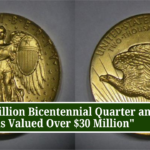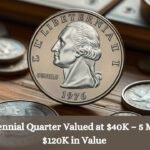Introduction
You should keep it in your pocket now. The 1975-1976 bicentennial commemorative coins in particular sparked a collecting frenzy that carried information about a variety of rare coins worth about $2.2 billion in the US. financial ho came.
Created to celebrate America’s 200th birthday, these four spots are incredible pieces of monetary history. Although most retain their coin value of 25 cents, some error coins and rare variations have attracted the attention of serious collectors and casual coin enthusiasts.
The search for these valuable real estate continues today, many years after they were first abandoned. You may find valuable error coins or silver items mixed in with your regular change. Collectors across the country often look at their residences, hoping to find some unique items that might indicate the value of rare coins.
The next few changes you make can make a piece of American history worth more than it’s worth. The legacy of the Bicentennial is still there, showing that phenomenal discoveries in numismatics can still happen today.
The Allure of the Bicentennial Quarter

A special coin celebrating America’s 200th birthday in the 1976 bicentennial year. U.S. It was created by the Mint in 1975 as part of a major project to celebrate its milestone year.
Unique Design Features
One of the most appealing aspects of the Bicentennial Quarterly is its design. Unlike other lobster displays, this coin has a colonial drummer on the reverse. This painting represents the spirit of the American Revolution and is a monument to our nation’s War of Independence.
- Face Mask: The quarter cover still features an image of George Washington as in previous editions.
- Reverse: The reverse shows a Colonial drummer looking left, and the dates “1776-1976” are clearly indicated.
Production Locations
To create this special habitat, the U.S. Mint produced in three different locations.
- Philadelphia (no mintmark) .
- Denver (D mint mark) .
- San Francisco (S mint mark) .
This means that if you look closely at your building, you can tell where it was made based on the mint marks or lack thereof.
Understanding the Value of a Bicentennial Quarter

Two hundred year values vary greatly depending on condition and mint location. Regular coins at the Philadelphia Mint typically weigh 25 cents, while uncirculated coins can fetch $1 to $5.
Mint State Values:
- MS-63 grade: $5-$10
- MS-65 grade: $15-$25
- MS-67 award: $50-$100
The San Francisco Mint produced proof versions for special collectors, and commissioned price increases:
- Proof fee: $5-$15
- Silver certificate fee: $15-$30
The product numbers paint an interesting picture of availability:
- Philadelphia Mint: 809,784,016 quarterly
- Denver Mint: 860,118,839 quarterly
- San Francisco Mint (proof): 7,059,099 quarterly
Position plays an important role in pricing. The main causes are:
- Page protection
- Strike properties
- Original mint sheen
- Absence of contact signs
Certifications and grades are provided by professional grading bodies such as the PCGS and the NGC, providing reliable objective assessment for serious collectors. Their certification can have a significant impact on the market value of the currency.
Discovering Hidden Treasures: Rare Error Varieties and the Silver-Clad Variant

Among the most valuable bicentennials are coin models that have clear mint flaws, differentiating the particular edition from other more common editions. These rare changes can make a 25-cent coin so special and potentially high-dollar collector’s item.
Notable Error Types:
- Double Strike – The coin was struck multiple times, creating overlapping images
- Off-Center Strikes – Design elements appear shifted from their default positions
- Die Breaks – Raised lines or grooves due to the death of damaged mint
- Missing Elements – Quarters without unique design features
- Broadstrikes – The coin strikes colorless, resulting in a broad look
The silver-covered road represents another treasure hunt in the Bicentennial Quarterly Series. This special edition has a silver content of 40%, which sets it apart from the standard copper and nickel plated versions. You can see the different elements of the quilt:
Silver Variant Characteristics:
- A specific tap and ring
- It is slightly heavier at 5.75g vs 5.67g
- “S” mint mark indicating San Francisco production
- Proof-like wall style
- Darker toning patterns compared to standard quarters
Professional engravers certify these valuable changes, and the price ranges from hundreds to thousands of dollars depending on the type and condition of error Highly specialized specimens, especially those with multiple imperfections or antique silver a organized, command higher prices in the money market.
Understanding Why Numismatists Love Bicentennial Quarters

It has also brought a tremendous growth to the banking community because of digital strategies creating hotspots for bicentennial and quarterly enthusiasts. Popular forums, like Reddit r/coins, join the interest with dedicated Facebook groups connecting collectors all over the world and allowing for real-time conversations about their rarity and market values.
These online communities are valuable educational resources:
- Knowledge sharing: Experienced collectors share loyalty tips and price insights
- Trading opportunities: Members buy, sell and trade currencies directly in these units
- Documents: Collectors present their finds through beautiful photographs
- Market Update: Real-time discussion of current market trends and pricing
The rise of social media has given the younger generation a new interest in finance. Bicentennial hunts are other topics on the YouTube fundraising channels that attract thousands of views. Such events require much vitality at play, and as experienced collectors interact with newbies, it creates camaraderie that everyone will be interested in this historic coin.
With the coming of online markets like eBay, locators nowadays look for rare specimens differently. The flaws and silver-plated ones in a Bicentennial Quarter are easier to spot. Moreover, with collecting coins, happiness had transcended beyond a hobby for many; some consider it an investment opportunity. Money, Notes, and how if done wisely, collecting can be very profitable.
Conclusion
The search for a two- and four-century rarity brings unique interest to the collecting industry. Each quarter you examine can hold significant hidden cash value – from uncirculated pieces of antiquity to interesting mistakes. Perhaps a valuable piece of American history waiting to be discovered in your pocket change.
The historical significance of noteworthy coins such as those minted in the second and fourth centuries adds depth to this worthwhile hobby. As you learn about the most valuable coins to accumulate, you will develop a sharper eye and a deeper appreciation for money.
Get collecting today-that quarter in your pocket could cost you a heck of a lot more than 25 cents. Now, that $2.2 billion offer might be enough to make most anyone’s head spin, but shallow collectors like you waiting to be discovered just means there are real treasures to go around.
FAQ’s
What is the significance of the two centuries?
Built between 1975 and 1976, the Bicentennial Quarter is significant to US history. Due to its unique design with colonial violinists and ‘1776-1976’ inscriptions, collectors prize it for its aesthetic appeal and probable utility as a rarely inserted coin.
What should I do if I have two hundred precious years?
If you find a valuable bicentennial third year, consult a numismatist or dealer. They can accurately appraise it and advise you on retaining or selling it.
What are some of the rare species in the Bicentennial Quarter?
Rare variants of the Bicentennial Quarter with mint faults like double striking, off-center striking, etc. might raise its value. Additionally, the standard quarter’s silver plating is distinctive and more expensive because to its composition.



